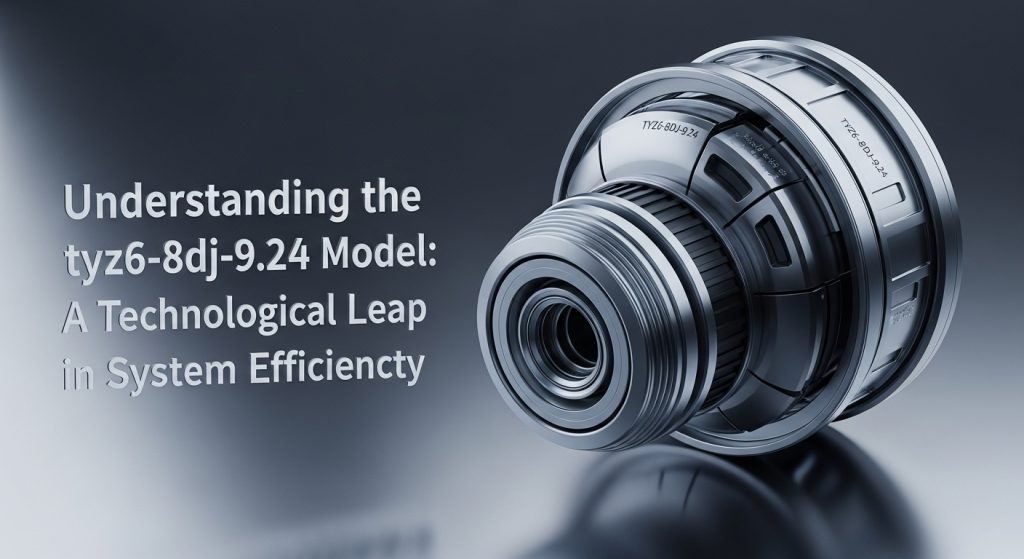
The rapid evolution of technology has introduced new models and frameworks that aim to solve increasingly complex challenges in data handling, automation, and system optimization. Among these innovations, the tyz6-8dj-9.24 model stands out as a versatile, performance-driven solution designed for both enterprise and industrial use. With applications ranging from smart systems to predictive analytics, the model is creating buzz across several sectors.
This article offers an in-depth look at what the tyz6-8dj-9.24 model is, how it works, its core advantages, potential applications, and the impact it could have on modern system architecture.
What Is the tyz6-8dj-9.24 Model?
At its core, the tyz6-8dj-9.24 model is a modular processing and control framework that integrates artificial intelligence (AI), machine learning (ML), and real-time operational feedback. It is designed to improve system responsiveness, adaptability, and long-term efficiency. By combining algorithmic decision-making with reactive analytics, the model can respond to system inputs almost instantaneously while adapting over time to changing conditions.
What makes the tyz6-8dj-9.24 model particularly notable is its emphasis on self-regulation and dynamic scalability. It can be deployed in environments ranging from small-scale embedded systems to expansive industrial networks.
Architecture and Functionality
The structure of the tyz6-8dj-9.24 model is both robust and flexible. It features a three-tiered design that enables efficient data intake, intelligent processing, and effective system response.
1. Input Gateway
This layer handles the collection and normalization of incoming data. Whether it’s sensor readings, cloud-based inputs, or data from APIs, the input gateway converts everything into a standard format that the system can process in real time.
2. Central Processing Core
The model’s core integrates machine learning modules, rules engines, and optimization algorithms. This is where the magic happens: raw data is analyzed, patterns are detected, and decisions are made. Over time, the core “learns” from previous outcomes to improve future responses.
3. Adaptive Output Interface
The output module ensures that the system’s reactions—be it an alert, an adjustment in a connected device, or an update to a database—are timely and accurate. It maintains feedback loops to fine-tune future interactions based on success metrics.
Unique Features of the tyz6-8dj-9.24 Model
The appeal of the tyz6-8dj-9.24 model lies in its intelligent design and broad capabilities. Some of its most notable features include:
- Real-Time Learning: As the system operates, it continuously refines its models to improve decision-making.
- Plug-and-Play Modularity: Components can be swapped or upgraded without having to redesign the entire system.
- Predictive Maintenance Support: The model can anticipate component failures or system inefficiencies before they occur.
- Edge Computing Compatibility: The tyz6-8dj-9.24 model can be deployed on localized systems for faster processing without relying on the cloud.
- Energy-Efficient Processing: Optimized to reduce computational load and power consumption.
These features make it suitable for a wide range of use cases, especially in areas where quick and accurate decision-making is essential.
Applications Across Industries
The tyz6-8dj-9.24 model is not confined to a single niche. Its flexible architecture and robust processing capabilities make it adaptable across various fields.
1. Manufacturing and Industrial Automation
In manufacturing plants, the model can be used to monitor production lines, adjust machinery in real-time, and detect quality issues before they escalate. Its predictive capabilities help reduce downtime and enhance productivity.
2. Smart Homes and Buildings
For intelligent building systems, the tyz6-8dj-9.24 model can regulate lighting, temperature, and security systems. It can learn occupants’ habits and optimize settings to enhance comfort and energy efficiency.
3. Healthcare Devices
In medical technology, the model powers patient-monitoring devices that need to deliver accurate and timely alerts. It helps detect anomalies in vital signs and supports faster intervention.
4. Transportation and Logistics
Fleet tracking, route optimization, and automated delivery systems benefit from the model’s ability to process data from multiple sources and react instantly to changing conditions on the ground.
Advantages of Implementing the tyz6-8dj-9.24 Model
Businesses and developers stand to gain several benefits by adopting the tyz6-8dj-9.24 model:
- Cost Efficiency: Reduces manual labor and system errors through automation and smart learning.
- Faster Time-to-Insight: Real-time data processing shortens the gap between data collection and actionable decisions.
- Increased Uptime: Predictive maintenance minimizes breakdowns, ensuring smoother operations.
- Future-Proofing: The modular design allows for easy upgrades and compatibility with emerging technologies.
Moreover, the model supports open-source environments and popular APIs, which lowers the barrier to entry for businesses of all sizes.
Implementation Challenges
Despite its many benefits, deploying the tyz6-8dj-9.24 model isn’t without challenges. Understanding these can help organizations prepare for a smoother transition.
- Initial Setup Complexity: Requires trained professionals to configure the system properly.
- Data Dependency: The model performs best with clean, continuous data input.
- Integration Costs: Older systems may need significant updates to be compatible with the new model.
However, most of these hurdles are one-time concerns. Once implemented, the model’s autonomous capabilities quickly deliver measurable ROI.
Security and Compliance
Security is a crucial aspect of the tyz6-8dj-9.24 model. It includes built-in data encryption, identity verification mechanisms, and multi-level access control. It also complies with global data protection standards such as GDPR, HIPAA, and ISO 27001.
Regular security updates and threat detection protocols ensure that the system remains safe against both internal and external risks.
The Future of the tyz6-8dj-9.24 Model

As industries continue to shift toward automation and smart systems, the tyz6-8dj-9.24 model is well-positioned to become a foundational tool in next-gen infrastructure. Planned enhancements include:
- Quantum-ready Processing Cores
- Blockchain Integration for Immutable Logs
- Voice and Natural Language Processing Modules
- AI-driven Visualization Dashboards
These advancements will further solidify the model’s place in mission-critical environments, providing even more control and intelligence to system operators.
Conclusion
The tyz6-8dj-9.24 model represents a new frontier in data-driven automation and intelligent system design. With its modular framework, adaptive capabilities, and strong real-time processing power, it addresses many of the limitations found in older systems.
From factories to hospitals, smart homes to logistics networks, this model is unlocking new levels of performance, efficiency, and insight. As technology continues to evolve, models like tyz6-8dj-9.24 will play a pivotal role in shaping the systems of tomorrow.
If your organization is seeking to optimize operations and gain a competitive edge through smart technology, now is the time to consider what the tyz6-8dj-9.24 model can offer.


